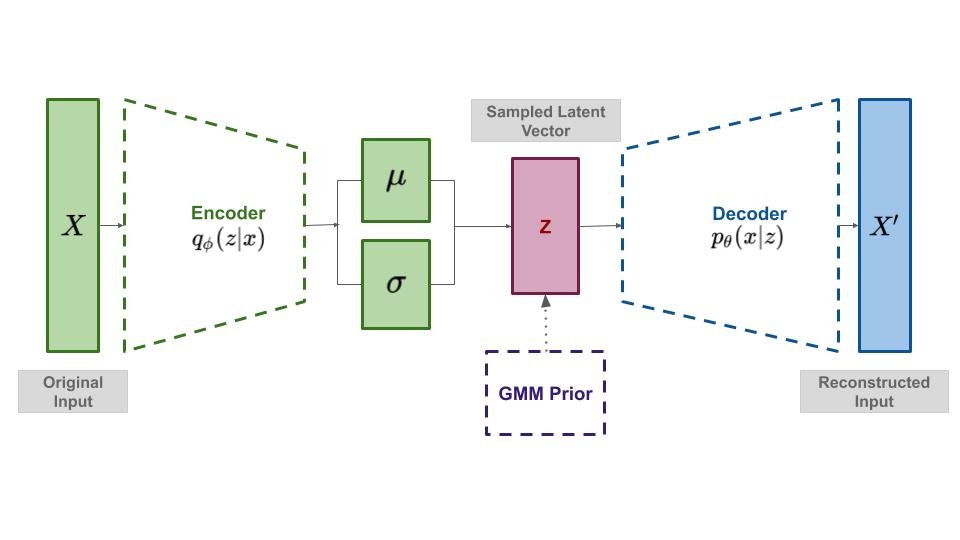Jill-Jênn Vie
Researcher at Inria
% TabDDPM: Modelling Tabular Data with Diffusion Models % Jill-Jênn Vie % MILLE CILS 2023 — aspectratio: 169 institute: \includegraphics[height=1cm]{figures/inria.png} \includegraphics[height=1cm]{figures/soda.png} header-includes:
-
\def\E{\mathbb{E}}
Context
Generating synthetic data that follows similar distribution than real data
Potentially with privacy guarantees
Contributions
- TabDDPM for \alert{denoising diffusion probabilistic models} (DDPM) for tabular data with categorical and continuous features
- Outperform GAN and VAE
- More private than a simple counterpart (SMOTE)
Metrics
High ML efficiency
- Average of weak learner should be efficient (good $R^2$) for both real and fake data
- Strong learner (gradient boosting tree) should also have good $R^2$ for both real and fake data
High distance to closest record
To mitigate privacy issues
Low difference between correlation matrices
Baselines
Several GAN-based
SMOTE is a shallow interpolation-based method that “generates”
a synthetic point as a convex combination of a real data point and its $k$-th nearest neighbors
from the dataset
(originally proposed for minor class oversampling, here for synthetic data generation)
Experiments on 15 real-world public datasets
Results I: High ML efficiency
- Average of weak learner should be efficient (good $R^2$) for both real and fake data

- Strong learner (gradient boosting tree) should also have good $R^2$ for both real and fake data

Results II: High distance to closest record


Results III: Low difference between correlation matrices
\centering
 {width=95%}
{width=95%}
TabDDPM model

- Continuous variables: Gaussian diffusion model
- Categorical variables: Multinomial diffusion model
What are diffusion models? (Check Lilian Weng’s post!)
\centering
 {width=85%}
{width=85%}
Intro: variational autoencoders
\centering
 {width=75%}
{width=75%}
\vspace{-1cm}
\raggedright
-
Encoder: $x \mapsto z$ with posterior $q_\theta(z x) = \mathcal{N}(\mu, \sigma) \simeq p(z x)$ -
Decoder: $z \mapsto x$ with likelihood $p_\theta(x z)$
Kingma, Diederik P and Welling, Max. Auto-Encoding Variational Bayes. In The 2nd International Conference on Learning Representations (ICLR), 2013.
VAE objective
\[\log p(x) \geq \E_{q(z)} \left(\log p(x|z)) - KL(q(z)||p(z))\right)\]\centering
 {width=70%}
{width=70%}
\raggedright
Variational Inference: Foundations & Innovations (Blei 2019)
Back to the paper: diffusion model objective
:::::: {.columns}
::: {.column width=60%}
\begin{align}\label{eq:elbo}
\log q\left(x_0\right) \geq & \mathbb{E}_{q\left(x_0\right)} \big[\underbrace{\log p_{\theta}\left(x_0 | x_1\right)}_{L_0} - \underbrace{KL\left(q\left(x_T|x_0\right) | q\left(x_T\right)\right)}_{L_T} -
& \sum_{t = 2}^T \underbrace{KL\left(q\left(x_{t - 1}|x_t, x_0\right) | p_{\theta}\left(x_{t - 1} | x_t\right)\right)}_{L_t}\big]
\end{align}
:::
::: {.column}
\includegraphics{figures/DDPM.png}
:::
::::::
:::::: {.columns} ::: {.column}
Continuous are Gaussian
\begin{align}
& q\left(x_t | x_{t - 1}\right) := \mathcal{N}\left(x_t; \sqrt{1 - \beta_t}x_{t - 1}, \beta_t I\right)
& q\left(x_T\right) := \mathcal{N}\left(x_T; 0, I\right)
& p_{\theta}\left(x_{t - 1}| x_t\right):= \mathcal{N}\left(x_{t - 1}; \mu_{\theta}\left(x_t, t\right), \Sigma_{\theta}\left(x_t, t\right)\right)
\end{align}
Parameterization trick so that the $KL$ becomes $L^2$ over noise variance component. ::: ::: {.column}
Categorical are Multinomial
\begin{align}
& q(x_t | x_{t - 1}) := Cat\left(x_t; \left(1 - \beta_t\right)x_{t - 1} + \beta_t / K\right)
& q\left(x_T\right) := Cat\left(x_T; 1/K\right)
& q\left(x_t | x_{0}\right) = Cat\left(x_t; \bar{\alpha}_t x_{0} + \left(1 - \bar{\alpha}_t\right)/ K\right)
\end{align}
$q(x_{t - 1}|x_t, x_0)$ has closed form. ::: ::::::
Ethics slide
Because of GDPR this research exists
As even people who are supposed to have access to the data are not having access to the data (non-asymptotically)
Risks of creating whole fake datasets in order to support some claim
(generation of fake datasets conditioned on the results)
\vspace{1cm}
Akim Kotelnikov, Dmitry Baranchuk, Ivan Rubachev, Artem Babenko.
\alert{TabDDPM: Modelling Tabular Data with Diffusion Models.} Proceedings of the 40th International Conference on Machine Learning, PMLR 202:17564-17579, 2023. https://arxiv.org/abs/2209.15421
\vspace{1cm}
Thanks and see you around! jill-jenn.vie@inria.fr